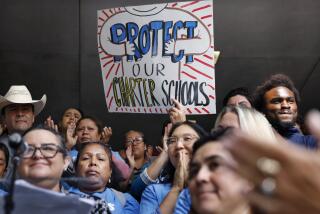Zero-tolerance policies pushing up school suspensions, report says
In the decade since school districts instituted “zero tolerance” discipline policies, administrators have increasingly suspended minority students, predominantly for nonviolent offenses, according to a report released Wednesday.
The National Education Policy Center found that suspensions across the country are increasing for offenses such as dress code and cellphone violations. Researchers expressed concerns that the overuse of suspensions could lead to dropouts and even incarceration.
Suspensions are falling mostly on black students; nearly a third of black males in middle school have been suspended at least once, researchers from the University of Colorado-based group found.
In Los Angeles Unified, one of the school systems included in the report, district figures show a similar situation: Last school year, nearly 34% of students suspended from middle schools were African American, while about 11% were Latino, 5% were white and 3% were Asian. The district, the nation’s second largest, had nearly 74% Latino students, 10% African American, nearly 9% white and nearly 4% Asian.
Yet L.A. Unified, with an overall suspension rate of 6.9%, fell below the state average of nearly 12%, according to the California Department of Education.
Los Angeles schools Supt. John Deasy said his district is examining why students are suspended and considering alternatives. “It’s not violence, not weapons — it’s defiance,” Deasy said, referring to the reason most students are suspended. With issues of defiance, he said, “there are ways to work with our youth in a restorative way rather than a punitive way.”
State officials this week have urged school districts to change course in order to keep students on campus. “We need to hold kids accountable and help them learn from their mistakes, but also keep them in school and on course to graduate,” Atty. Gen. Kamala Harris said in a statement. The veteran prosecutor said that “out-of-school suspension for nonviolent offenses can set the stage for the type of chronic truancy that leads to students dropping out of school and becoming victims of crime.”
Yet Daniel Losen, author of the National Education Policy Center report, said many districts across the country are “holding onto this idea that we have to kick these kids out so the good kids can learn.”
Districts’ zero-tolerance policies — which have relied heavily on suspensions — mostly began after the deadly Columbine school shootings in 1999.
As a result, offenses that probably would have once merited a visit to the principal’s office now require suspension. Students who wore gang colors, carried a cellphone, were truant or persistently tardy were among those most commonly suspended, Losen found.
Losen, director of the Center for Civil Rights Remedies at UCLA, pointed to the Baltimore public schools as an example of the type of success that districts can have when they find alternatives.
Officials in Baltimore have decreased the number of suspensions from 26,000 to 10,000 per year by limiting the number of offenses that require sending students home, and the district’s graduation rate increased by 20% during that same period.
Those results, Losen and others say, come by way of simple and cheap alternatives. Schools could institute a peer judicial system and additional classroom and behavioral management training for teachers.
The objective, they say, should be to keep students in school where they could receive help.
“A child who is suspended from school is more than likely waving a red flag for needing intervention and support,” said Dr. Robert Ross, president and chief executive of the California Endowment. “Metaphorically speaking, this is a time you want to put your arms around a student, rather than push them away.”
More to Read
Start your day right
Sign up for Essential California for news, features and recommendations from the L.A. Times and beyond in your inbox six days a week.
You may occasionally receive promotional content from the Los Angeles Times.






